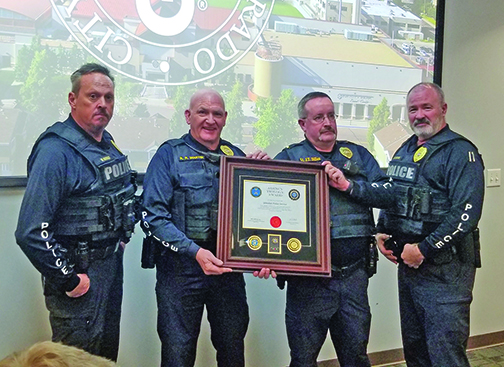
by Laura Lieff | Jan 21, 2022 | Glendale City News
by Laura Lieff
The Glendale Police Department started 2022 off with high honors. At the January 4 Glendale City Council meeting, officers from multiple divisions — including dispatchers, patrol officers, detectives, victims advocates, evidence technicians, and records technicians — were awarded a Unit Citation for their outstanding performance in two complex cases from 2017 and 2019.
“Everyone worked extremely hard on these complicated cases and that thoroughness resulted in identifying suspects and getting confessions,” says Chief William Haskins.

High Honors: The Glendale PD command staff earned the coveted Trilogy Award for completing all three FBI Law Enforcement Executive Development Association courses.
In October 2017, the manager was shot at Shotgun Willie’s when a small group was denied entry. As soon as the Glendale PD dispatchers received the call, they began collecting information which allowed officers to get to the club quickly and restore order in a chaotic situation. Haskins says the officers collected statements from people who were on scene and then detectives began digging through the information.
“Unfortunately, situations happen when there just isn’t enough information to show prosecutors,” Haskins explains. “But in this case, everyone continued pursuing every lead available until they were finally able to identify the suspect who was already in custody in federal prison on unrelated charges. Our detectives got a confession, and the suspect took a plea bargain for 18 years.”
Diligence And Hard Work
In November 2019, the Glendale PD received several calls at 3 a.m. about shots fired in the area. Officers arrived on scene and found a car, riddled with bullet holes, that had driven off the side of the road. The driver had also been shot to death. Although Haskins describes the amount of evidence as minuscule, Glendale detectives eventually figured out that the shooting was part of a much larger series of incidents involving the MS-13 crime gang operating in Colorado.
“We worked with other jurisdictions, the violent crimes task force, and ATF because the criminal subculture around MS-13 is that they don’t talk,” says Haskins. “By coordinating with these other agencies — and through good old-fashioned policework — they were able to identify the suspects and bring forth charges.”
As a result of the Glendale PD’s hard work and persistence, the District Attorney’s office felt they had enough evidence to prosecute. Although the MS-13 case is still ongoing, and hasn’t gone to trial yet, the Glendale team was able to put the pieces of the large, complex puzzle together and identify suspects.
FBI Training
In addition to the effort put into the 2017 and 2019 cases, the Glendale PD’s Command Staff — including Chief Haskins, one captain, and two lieutenants — took time to sharpen and update their skills by completing FBI Law Enforcement Executive Development Association (LEEDA) courses. According to the website, the FBI LEEDA provides executive law enforcement continuing education for police leaders across the United States.
LEEDA’s core training curriculum is comprised of three classes: Supervisor Institute, Command Institute, and Executive Institute. The Supervisor Institute covers personality diagnostics, leadership case studies, mentoring, performance and risk management, and credibility. The Command Institute discusses discipline and liability, dealing with problem employees, and leading change within an organization. The Executive Institute teaches trends in law enforcement, implications of the 21st Century Policing Report, bias and diversity, employee wellness, and transformational leadership.
According to Haskins, successfully completing just one of the three FBI LEEDA courses is a huge accomplishment for an individual. Completing all three — also known as the Trilogy Award — is extremely impressive. When an entire command staff takes law enforcement education even further by achieving all three, that is another level of excellence.
“When I took over as chief, I wanted Glendale to be the best police force in the nation, and that includes ongoing training at various levels,” Haskins explains. “This is a huge achievement for our department because it enables everyone to use the same tools to move the agency forward.”
Adds Mayor Mike Dunafon, “It’s an honor to work alongside the men and women of the Glendale Police Department. They work tirelessly to keep the citizens and businesses of Glendale safe and truly embody the spirit of the motto ‘to protect and serve.’”

by Glendale Sports Center | Dec 17, 2021 | Glendale City News
by Jessica L. Giffin, MPH, CHES, NBC-HWC, Director of Health Partnerships, YMCA of Metro Denver
 Take a second and picture your neighborhood. Where is the closest grocery store? Is it easy to get there? Some communities have multiple grocery stores within walking distance, but many communities don’t have easy access to a full-service grocery store. They may have to travel far to find one or rely on convenience stores which are often more expensive and have fewer healthy options.
Take a second and picture your neighborhood. Where is the closest grocery store? Is it easy to get there? Some communities have multiple grocery stores within walking distance, but many communities don’t have easy access to a full-service grocery store. They may have to travel far to find one or rely on convenience stores which are often more expensive and have fewer healthy options.
Communities that don’t have access to affordable and nutritious food are known as “food deserts.” You can often find food deserts in urban spaces, rural areas, and low-income neighborhoods. People with chronic illnesses or disabilities may also have less access to grocery stores. This lack of access can lead to food insecurity and impact overall health.
It’s difficult to eat healthy if someone doesn’t have access to fresh produce or if their neighborhood is full of fast-food restaurants. Access to foods that aid healthy eating affects someone’s health throughout their life. Because healthy eating can lower your risk for certain chronic health conditions, people that can’t regularly get nutritious foods are more likely to develop obesity and diabetes.1
The YMCA of Metro Denver also runs a program for the community called Beyond Hunger to give food to people in our community who need it. Our nutritionists work with Beyond Hunger to make sure people get items that will nourish them, help them feel good, and are culturally relevant.
Health is more than what medicines you take or how often you see a health care provider. Your lifestyle, including what you eat, plays a big role in your health! That’s why it’s important that everyone has access to affordable and nutritious food.
We hope that we can learn more about how environment and lifestyle can impact health. That will take more research! If you want to help scientists find out more about health and how every community has different experiences, here’s how you can play a part.
The National Institutes of Health’s All of Us Research Program is bringing together at least a million volunteers to share information about their lifestyle, health needs, where they live, and more to get a better picture of everything that makes up health. That way health care providers, nutritionists, maybe even city planners, can make more personalized choices for every person and community.
There are a number of ways you can help advance health research with All of Us, including taking their newest survey about social determinants of health. These are your life experiences that impact your health – like how close your nearest grocery store is and what kind of food it sells!
If you’re interested in helping researchers learn more about how your lifestyle and community impact health, visit Join AllofUs.org/togetherDENVER.
1 HealthyPeople.gov, “Access to Foods that Support Healthy Eating Patterns.”

by Glendale Sports Center | Nov 19, 2021 | Glendale City News
 Here Are 3 Tips To Stay Balanced
Here Are 3 Tips To Stay Balanced
by Jennifer Lease, RD, CDN, Director of Nutrition Initiatives, YMCA of Metro Denver
Are thoughts of all the holiday sweets and treats causing you stress?
Do you feel like you can’t enjoy your favorite holiday foods when you’re working on your health?
Are you worried that what you eat during the holidays will throw off progress toward your goals?
You’re not alone!
The holiday season is a time of celebration that usually comes with lots of sweets, treats and traditional dishes that feel indulgent. It can be difficult to find balance during the holidays — wanting to enjoy all the foods you love while being mindful of your health.
You might hear that word balance and feel frustrated by it. What does it even mean? Balance means enjoying nutritious foods most of the time, while giving yourself grace (and space) to enjoy those sweets and treats.
So, how can you find that balance during the holidays and enjoy your favorite foods without the side order of guilt? Here are some tips:
- Balance your plate and practice portion control — You can enjoy a bit of everything with some balance and portion control. Plus, you’ll feel better after the meal, too! The basics of a balanced plate include protein, veggies, and a starch or grain. Try filling half of your plate with veggie dishes and then take a smaller portion of the others you want to try. Holiday dishes tend to be heavy, starchy foods, so don’t forget to add some protein like turkey or chicken to your plate to create that balance. Then, enjoy every bite!
- Move your body — Move your body, not because you think you should make up for eating those holiday treats, but because movement makes you feel good both physically and mentally. Movement can set a positive mindset for the day and the after affect is the feeling of doing something good for your body. Movement also helps with digestion. If you’re feeling super stuffed after a holiday meal, some exercise can help you feel better. Remember, it’s important to find exercise that you enjoy and that truly feels good for you. Exercise is often looked at as punishment for eating “badly,” but it’s really part of a healthy lifestyle that contributes to your overall well-being.
- Remember that every day is a new day — A healthy lifestyle should be sustainable. This means having flexibility and leaving space for the foods you enjoy. You don’t need to “compensate” for what you eat at the holidays. You don’t need to work out for three hours the next day to make up for last night’s meal. Instead, make the intentional choice to enjoy what you want and to be present in the holiday season. Each day is an opportunity to get back on track with your regular eating habits and routine.
Do you want to take the guesswork out of nutrition and work to set realistic healthy lifestyle goals? The nutrition team at the YMCA of Metro Denver can help. Reach out at nutrition@denverymca.org or visit us at denverymca.org.
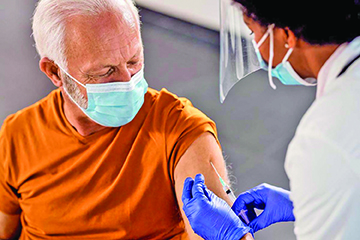
by Glendale Sports Center | Oct 22, 2021 | Glendale City News
by Jessica L. Giffin, MPH, CHES, NBC-HWC, Director of Health Partnerships, YMCA of Metro Denver
 November marks the beginning of the holiday season — a festive time when our thoughts turn to re-connecting with friends and loved ones to celebrate the holidays. During the colder Colorado months, we are gathering for celebrations that take place indoors and, as we know, that can put some of us at greater risk. Did you know that older adults with diabetes or pre-diabetes can be at higher risk for becoming very ill, particularly with COVID-19?
November marks the beginning of the holiday season — a festive time when our thoughts turn to re-connecting with friends and loved ones to celebrate the holidays. During the colder Colorado months, we are gathering for celebrations that take place indoors and, as we know, that can put some of us at greater risk. Did you know that older adults with diabetes or pre-diabetes can be at higher risk for becoming very ill, particularly with COVID-19?
During November — National Diabetes Awareness Month — it is a call to action for those at risk but there are some steps you can take to protect yourself.
Get Vaccinated
According to a study by the U.S. Department of Health and Human Services, coronavirus vaccines have prevented 265,000 infections, 107,000 hospitalizations, and 39,000 deaths from the virus in the first five months of this year.
Older adults with multiple underlying medical conditions are most at risk of serious illness. Throughout Denver and the state, there are many sites where you can get immunized. Check the Colorado Department of Public Health and Environment at covid19.colorado.gov for answers to frequently asked questions about the vaccine and convenient location of vaccine clinics.
Take Precautions While Traveling
Even though you may be vaccinated for COVID-19, there are rare breakthrough cases. In recent domestic travel guidance, the Centers for Disease Control recommends for those who are vaccinated to wear a mask and take precautions like hand washing and social distancing and then self-monitor for symptoms post-travel. For those who are unvaccinated, the recommendation is to take the same precautions in addition to getting tested 1-3 days before travel and 3-5 days after travel.
Reduce Your Diabetes Risk
Your age, lifestyle, and being overweight can put you at risk for diabetes. Taking a risk test or asking your doctor for a blood test. Type 2 diabetes doesn’t have to be permanent.
If you have prediabetes, there are things you can do to prevent or delay Type 2 diabetes. Consider joining the YMCA Diabetes Prevention program. Trained staff can help you make healthy food choices, get physically active and, in turn, lose weight, all of which can make a big difference! For those with Medicare Part B and United Health Care Advantage, the YMCA program is covered. Learn more and connect with our team at denverymca.org.
Stay healthy and safe this holiday season and beyond!
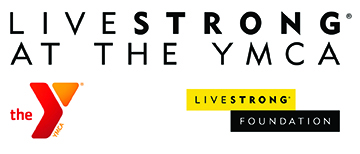
by Glendale Sports Center | Sep 27, 2021 | Glendale City News
by Cate Plekon, Lifestyle Medicine Manager, YMCA of Metro Denver
You can tell a friend about losing your hair or chemo, but if you haven’t been through it, it’s hard to understand. For Sandra, the Livestrong program gave her the chance to be with and talk to people who could relate to what she was going through. In Sandra’s case it was lymphoma.
Today Sandra is doing well and, in talking about her experience, says “I didn’t want the program to end. It made me exercise!”
In partnership with the Livestrong Foundation, the YMCA Livestrong program helps cancer survivors return to health after treatment. The 12-week program is offered at no cost to participants who have been diagnosed with cancer. Improving physical strength and endurance is our goal, but mental and emotional support is equally important. You do not have to be a member of the YMCA to be part of the program, but if you are not, you get a complimentary family membership for the duration of your time in the program. An extra incentive!
For Dave, a participant who underwent four cycles of chemo and 35 high doses of radiation, he needed guided support. “The impact of the program has been tremendous.”
We believe in total wellness at the YMCA. Through the Livestrong program, we meet participants exactly where they are. The program is open to any cancer survivor — you may be recently diagnosed, undergoing treatment, preparing for surgery, or a year into remission. We can help.
This is the fifth year of our program, and we are proud to have helped more than 100 participants through the program. While COVID-19 sidetracked in-person interaction in 2020, sessions continued virtually for those who were able to join. 2021 sessions restarted this month at the University Hills and Littleton YMCAs.
If you or someone you know wants to learn more about the Livestrong program at the YMCA, visit www.denverymca.org or contact us at communityhealth@denverymca.org.
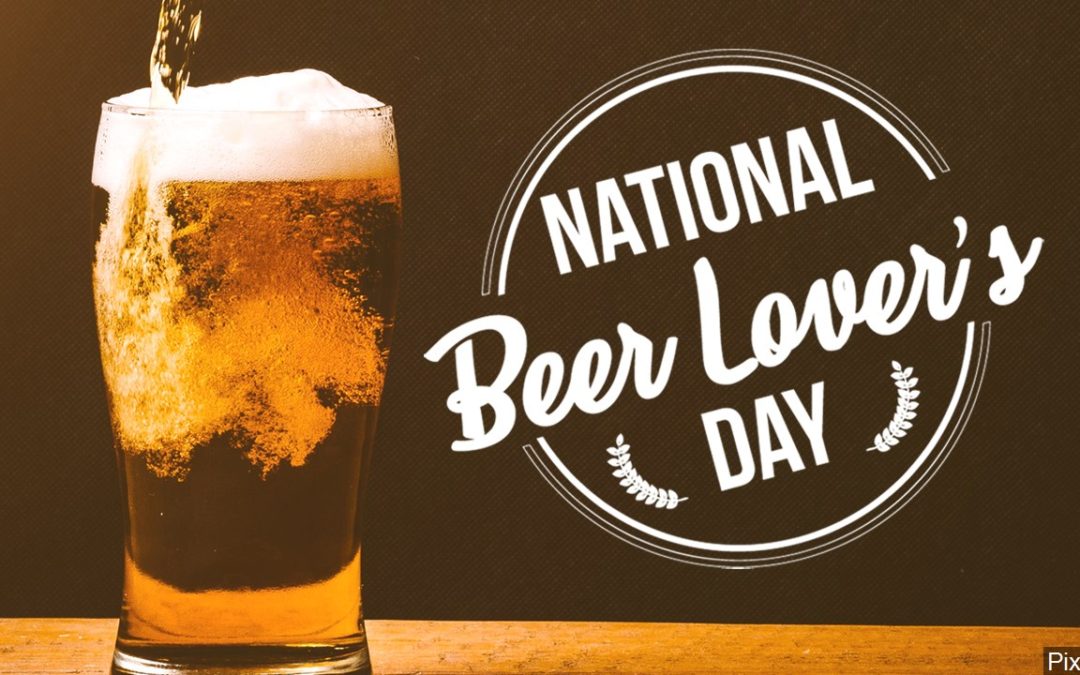
by Mark Smiley | Aug 27, 2021 | Glendale City News
WeldWerks And Boulder Beer Celebrate With Their Flagship Beers
by Mark Smiley
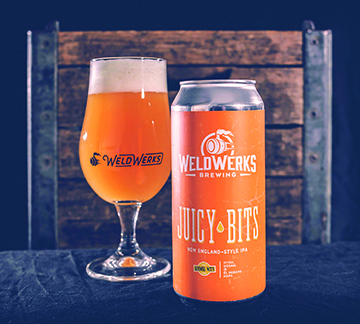
Juicy Bits: The flagship IPA from WeldWerks is regarded as one of the best IPAs in the country.
On September 7, 2021, National Beer Lover’s Day celebrates the grains, hops, and brewing methods across many eras. Beer and the process of brewing beer may predate known history. As varied as the methods, grains, and flavors, beer continues to change and evolve.
Virginia colonists brewed beer. William Penn included a place for brewing beer within the Pennsylvania colony. It can still be visited at Pennsbury Manor today. The first President of the United States recorded a recipe for brewing beer in his notes. Samuel Adams holds a place in both beer and tea history in this country. There were a few beer lovers and patriots among the nation’s founders.
The United States also derives its rich brewing history from beer-loving German immigrants during the mid-1800s. Some of those family names are as familiar today as they were 100 years ago.
While some names have faded into the past, smaller batch brewers continue to experiment with old and new recipes. The crafting of beer carries deep traditions, often requiring years of training and experience in the trade. Depending on the brewery, the path to brewmaster may take years to develop the skill and expertise. Eventually, a brewmaster gains the knowledge necessary to produce a quality beer every time. One particular requirement is a passion for the craft.

Advanced Fluid Dynamics: A New England Double IPA that starts with orange creamsicle and vanilla notes from the Lotus, and then Sabro is added to bring in some more tropical notes, specifically coconut.
The brewer will master lagers, ales, malts, and stouts. They may even specialize. However, their ability to ferment the perfect beer under each condition and bring out the flavor of the grain and yeast will be key. Managing temperature and timing for an IPA or studying grains all go into their education. Each process varies, and a brewmaster knows this.
Neil Fisher, Co-Founder and Brewer at WeldWerks Brewing Co. in Greeley, is such a

Hazed & Infused: The brewers at Boulder Beer Company have blended together four different hop varieties to give Hazed a unique aroma, with just enough yeast for a full mouth feel and a smooth, easy finish.
brewer. Juicy Bits, their New England IPA brewed with Citra, Mosiac, and El Dorado hops is the flagship beer for WeldWerks. It can be found in most liquor stores and is regarded as one of the best IPAs in the country. It scores a 95/100 on the popular Beer Advocate website which is no small feat.
WeldWerks also has Advanced Fluid Dynamics: Cryo Hop Double India Pale Ale brewed with Cryo Citra and Cryo Sabro hops and Lupulin Lotus Powder. It checks in with an 88/100 score and is another solid beer worth considering when picking up your next beer for the National Beer Lover’s Day holiday.
Another beer worth considering when stocking up is Hazed & Infused from Boulder Beer, an American Pale Ale. This beer is a unique infusion of floral hops that creates a piney, earthy, floral ascent, belayed by a complex, dank, and fruity backbone. It also ranks high with an 83/100 score on Beer Advocate.
The next time you visit a liquor store and are considering buying beer but are confused by the plethora of options, these three are safe bets and most likely will please a variety of palates.












